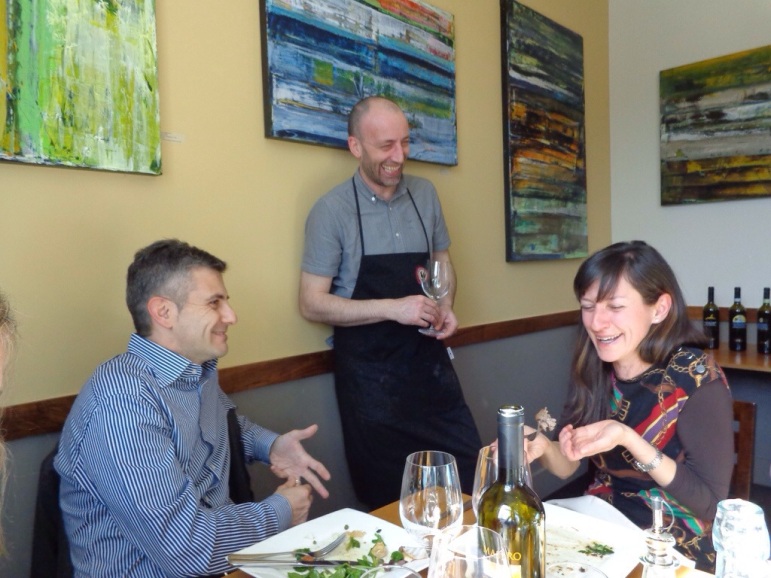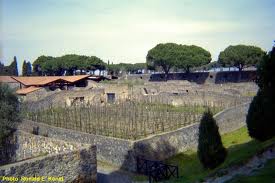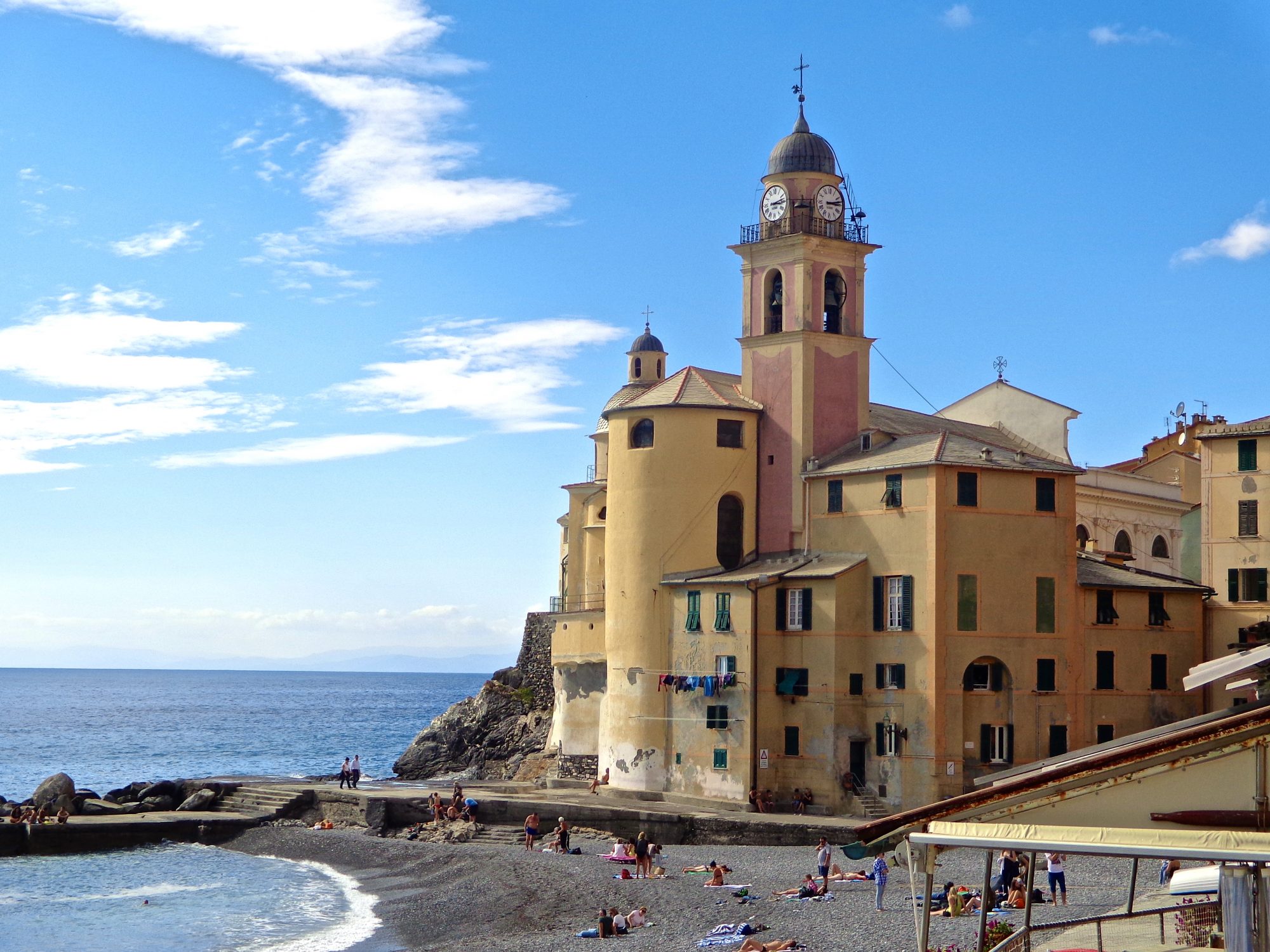Among my very favorite things to do while in bella Italia is to visit the wineries. As one of the oldest wine-producing regions in the world, some of the very best come from Italy. Italy supplies nearly one-third of the global wine production. In fact, Italy is now the world’s largest wine producer by volume, closely followed by France. With more than one million vineyards under cultivation, Italian vintners know a thing or two when it comes to making delicious wine. Read more
Tag: Mastroberardino
Wine and Dine with Italy’s Piero Mastroberardino

Bright sunlight breaks through the gray clouds as I enter Trattoria Gallo Nero in downtown Portland, Oregon. Greeted by warm smiles from my Italian meet up group in the small dining room, I catch a glimpse of Piero Mastroberardino, President of the Mastroberardino Winery in Campania. His lovely teenage daughter stands beside him as he converses with the guests. Sharply dressed in a stylish gray coat, his manner is authentic.
“I have visited your beautifully artistic cellars in Atripalda just this last September,” I inform him. He smiles and humbly accepts my praise. He is gentle and approachable.
Piero is here in the U.S. on a 10 day tour. After his arrival, he attended a memorial service for his father Antonio in New York. A legendary patriarch of the Mastroberardino family, Antonio refused to give in to the pressure and cultivate non-native vines. Instead, he fought staunchly to preserve the original varietals introduced by the ancient Greeks and Romans.
Piero is experiencing the fruit of Antonio’s labor. As President of the Mastroberardino empire, his winery is the only one given permission by the Italian state to research the ancient wine varietals grown in Pompeii and to replant them on their original plots. The resulting wine from the small yearly harvest is named “Villa dei Misteri.” (See my post, Mastroberardino Restores the Ancient Wines of Pompeii, and ~ Resurrecting the Ancient Wines of Pompeii for more information.)
All of the wine is made at the cellars in Atripalda, Campania. Mastroberardino cultivates their vines on approximately 500 acres of mountainside terroir steeped with ash. The elevation can run high as Piero mentions some of the vineyards are not far from snow.


Davide (center) is a Florentine who is the chef for Trattoria Gallo Nero. His specialty is tasty Tuscan cuisine. Manuela, seated on the right, grew up just outside of Milan and leads the Italian meet up group. They are both very personable and fun to be with. Piero is also a business professor of economics at Foggia University during the winter while the winery slows down.


Four whites and two reds are present for tasting. Every one of them embodies an excellent taste and feel on the palate, with a warm and earthy essence. Lacryma Christi Del Vesuvio, Tears of Christ, is made in both a red and white. Pleasantly surprised, I found each one to be appealing to my taste.
Following are a few photos taken during our lunch with Piero. It lasted most of the afternoon and ended with many well wishes and good cheer.



We were honored to be in the presence of Piero Mastroberardino, a man who represents his fabulous wine estate with ease and finesse. He left a lasting impression of quality, distinction, integrity and a family pride that can only impress and leave one feeling richer for being there.
Below is a map of the Campania region in Italy and the Mastroberardino cellars/vineyards ~taken from the Mastroberardino website.
Mastroberardino Restores the Ancient Wines of Pompeii

Mastroberardino Winery has been introducing an incredible new concept to the wine world. With a long-standing family commitment of retaining the antiquity of their wine region of Campania in southern Italy, the archaeological superintendent of Italy has given Mastroberardino full rights since 1996 to discover and implement the ancient wine varietals that were grown in Pompeii prior to the devastation by Mt. Vesuvius in 79 AD. After years of on-site research, they have met with great success.
What methods were used in discovering these long-forgotten grape varietals? Did they plant vineyards in Pompeii? Have they produced a good wine from the harvest of these grapes?
Italian Talks has published my full article; Mastroberardino Masters the Ancient Wines of Pompeii. In this article, you will find the answers to these questions and more. The Mastroberardino family has put Campania back on the map as being the cultivators of premium wine that was once famous in antiquity. I hope you enjoy the article as much as I did while touring the cellars, researching and writing it.
I’m Going Back …..to Italia!
I am excited to announce my return to Italy in less than one week. I go with great expectations and a huge itinerary of new discoveries to make. There are so many more layers to experience and attempt to unravel about Italy that I must explore, to find out what lies around that next corner.
My itinerary has changed a thousand times since I first started planning my trip over the past year. There is so much I want to see and do yet. After much head scratching, this is what I have narrowed my three weeks down to…..(hard work)!!
After three days in Rome, I will head down to Naples and the wineries of Mastroberardino, where the original grapes of ancient Pompeii are being cultivated and once again made into the wine of the Roman emperors. My journey then takes me down to the UNESCO world heritage site of Matera in Basilicata. From there I will travel up to the Gargano Promontory, continue north along the Adriatic coastline and over to an agriturismo just outside of Florence. It is here I will tour the new Antinori Cantina and taste some of their exquisite Chianti and Super Tuscan wines, hopefully on horseback!
Along the way I will keep you posted with new photos and updates as often as possible. In a sense, I am taking all of you with me! I can’t wait to share the many dimensions of Italy that I have grown to love so much. Stay tuned….much more to come!
Tutto il mio meglio (All my best)
Susan
Resurrecting the Ancient Wines of Pompeii
What did the earliest Roman wines taste like? Were the highly appraised wines of the first century really worth their legendary status? Will we ever know?
List of suggested wines at bottom

When Vesuvius blew in August of 79 AD, ash covered the entire area of Pompeii and Herculaneum. The thriving seaport towns, once bustling with activity, became graveyards of civilizations frozen in time. There it lay undisturbed for eighteen centuries until it was excavated by Giuseppe Fiorelli, director of excavations from 1860 to 1875. Under twelve feet of solid ash, he discovered the decayed bodies of thirteen men, women, and children huddled together next to a stone wall inside their garden, where they suffocated in the swirling volcanic air.
Orchard of the Fugitives
Today the garden has been named the Orchard of the Fugitives. But instead of death, it is filled with green grass, robust grape vines, and fruit trees. Within the ruins of Pompeii, vineyards are being revived in an attempt to recreate the wines of the ancient Romans according to old Roman methods. In Pompeii’s heyday, vineyards grew in abundance in and around the city. The Villa dei Misteri, the project shared between the Archaeological Superintendence of Pompeii and Campania wine estate Mastroberardino, has been examining ancient frescos, root imprints, Roman authors, and DNA to identify the original grape varieties cultivated in Pompeii.

Is it actually possible to recreate the ancient Roman wines? Do the vines still exist?
Piero Mastroberardino, the winemaker in charge of the renown Mastroberardino winery in Campania, has been replanting vineyards in Pompeii using the same ancient grape varieties, viticulture and winemaking techniques of that period. Since the early 1700’s, the family has been dedicated to Aglianico, Fiano di Avellino, Greco di Tufo, among other varieties brought to Campania by ancient Greeks, producing consistently good quality wine.
Pompeii’s Applied Research Laboratory, founded in 1995, discovered plots of land pockmarked by holes that were evidence of vines and their supporting stakes. A year later these vineyards were replanted. The laboratory discovered that many of the green areas within Pompeii had been planted with grape vines. A dense concentration of them were situated close to the arena. In fact, all five vineyards discovered by the research lab were located near the coliseum.
Ancient Roman wine was very strong, but it was usually diluted with seawater before drinking. It was also used for medicinal purposes. Spices were added, or medicinal herbs to cure sickness. The Romans clearly understood alcohols ability to extract essential elements from herbs.
Pliny the Elder
Ancient Roman historian Pliny the Elder wrote extensively about wine. In his book Naturalis historia, he lists the grape varieties that were in common use. These were Greco, Fiano, Aglianico, Piedirosso, Sciascinoso, Coda di Bolpe, Caprettona, and Falanghina. These eight grape varietals are grown in Pompeii’s vineyards. Interestingly, it was the frescos found in Pompeii that partly identified the grape varietal as they each have their own shape. Studying DNA only gives the species, not the variety. Scientists at Pompeii were able to decipher the grape varietals through ancient texts, root imprints, and studies on climatic change as well.
“Campanian wines were considered the wines of the emperors, the wines for events,” states Mastroberardino. “They were the first to introduce the DOC,” he claims, referring to the rules that govern viticulture and labeling practices in Italy today. “On the amphorae of that period, you find the geographic origin of the wine, then the bolla, which is the seal of the producer, then the vintage.”

Today, restaurants and wine distributors carry Mastroberardino’s wines with honor. Their committment to tradition and cultivation of ancient grape varietals, and their ability to blend modern technology with time-tested techniques has placed the Mastroberardino winery as one of the most excellent in Campania.
So, here is your chance to taste the wines of the ancient Romans, made of the same grape varietals that were used over two thousand years ago, though not as strong, thankfully. Cultivated on the same soil around Vesuvius and nourished by the warmth of the sun, these wines are sure to please. Indulge in a glass and let your mind wander among the streets and shops of ancient Pompeii.
All wines may be purchased through wine shops or restaurants.
Recommended Mastroberardino Wines:
2011 Mastroberardino, Lacryma Christi del Vesuvio Bianco DOC $23–made entirely of an indigenous varietal called Coda di Volpe, it is a soft pale yellow in color with aromas of pears and apricots.
2011 Mastroberardino, Greco di Tufo DOCG $28–One of Italy’s most ancient grape varietals, Greco has been grown in Campania for thousands of years. It is an elegant, soft-bodied wine with a texture held together by a zesty acidity.
2011 Mastroberardino, Lacryma Christi del Vesuvio Rosso DOC $23–The red brother to its white sister, Lacryma Christi del Vesuvio Rosso shares the same legend and origin. An intense Ruby color, aromas of cherry and red berries, and soft flavors of plum, raspberry, and black pepper, this is the result of the Piedirosso grapes of this wine.
2010 Mastroberardino, Campania Aglianico IGT $28–Made from another ancient grape of Italy, Aglianico thrives in the volcanic soil and terroir of Campania. Blackberries and violets are the aromas one can find in a glass of this wine.
Related Articles:






